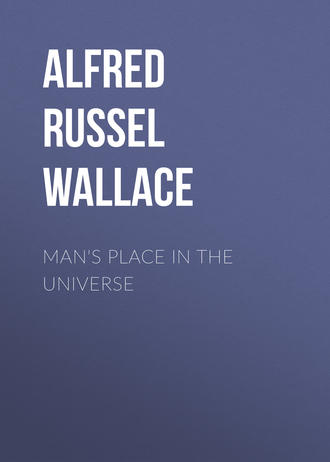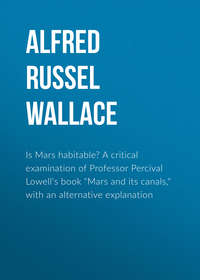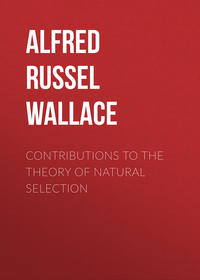 полная версия
полная версияПолная версия
Man's Place in the Universe
About this fact, then, there can be no dispute. A great circle is a circle dividing the celestial sphere into two equal portions, as seen from the earth, and therefore the plane of this circle must pass through the earth. Of course the whole thing is on such a vast scale, the Milky Way varying from ten to thirty degrees wide, that the plane of its circular course cannot be determined with minute accuracy. But this is of little importance. When carefully laid down on a chart, as in that of Mr. Sidney Waters (see end of volume), we can see that its central line does follow a very even circular course, conforming 'as nearly as may be' to a great circle. We are therefore certainly well within the space that would be enclosed if its northern and southern margins were connected together across the vast intervening abyss, and in all probability not far from the central plane of that enclosed space.
The Form of the Milky Way and our Position on its PlaneAlthough the Galaxy forms a great circle in the heavens from our point of view, it by no means follows that it is circular in plan. Being unequal in width and irregular in outline, it might be elliptic or even angular in shape without being at all obviously so to us. If we were standing in an open plain or field two or three miles in diameter, and bounded in every direction by woods of very irregular height and density and great diversity of tint, we should find it difficult to judge of the shape of the field, which might be either a true circle, an oval, a hexagon, or quite irregular in outline, without our being able to detect the exact shape unless some parts were very much nearer to us than others. Again, just as the woods bounding the field might be either a narrow belt of nearly uniform width, or might in some places be only a few yards wide and in others stretch out for miles, so there have been many opinions as to the width of the Milky Way in the direction of its plane, that is, in the direction in which we look towards it. Lately, however, as the result of long-continued observation and study, astronomers are fairly well agreed as to its general form and extent, as will be seen by the following statements of fact and reasoning.
Miss Clerke, after giving the various views of many astronomers—and as the historian of modern astronomy her opinion has much weight—considers that the most probable view of it is, that it is really very much what it seems to us—an immense ring with streaming appendages extending from the main body in all directions, producing the very complex effect we see. The belief seems to be now spreading that the whole universe of stars is spherical or spheroidal, the Milky Way being its equator, and therefore in all probability circular or nearly so in plan; and it is also held that it must be rotating—perhaps very slowly—as nothing else can be supposed to have led to the formation of such a vast ring, or can preserve it when formed.
Professor Newcomb considers, from the numbers of the stars in all directions towards the Milky Way being approximately equal, that there cannot be much difference in our distance from it in various directions. It would follow that its plan is approximately circular or broadly elliptic. The existence of ring-nebulæ may be held to render such a form probable.
Sir Norman Lockyer gives facts which tend in the same direction. In an article in Nature of November 8th, 1900, he says: 'We find that the gaseous stars are not only confined to the Milky Way, but they are the most remote in every direction, in every galactic longitude; all of them have the smallest proper motion.' And again, referring to the hottest stars being equally remote on all sides of us, he says: 'It is because we are in the centre, because the solar system is in the centre, that the observed effect arises.' He also considers that the ring-nebula in Lyra nearly represents the form of our whole system; and he adds: 'We practically know that in our system the centre is the region of least disturbance, and therefore cooler conditions.'
These various facts and conclusions of some of the most eminent astronomers all point to one definite inference, that our position, or that of the solar system, is not very far from the centre of the vast ring of stars constituting the Milky Way, while the same facts imply a nearly circular form to this ring. Here, more than as regards our position in the plane of the Galaxy, there is no possibility of precise determination; but it is quite certain that if we were situated very far away from the centre, say, for instance, one-fourth of its diameter from one side of it and three-fourths from the other, the appearances would not be what they are, and we should easily detect the excentricity of our position. Even if we were one-third the diameter from one side and two-thirds from the other, it will, I think, be admitted that this also would have been ascertained by the various methods of research now available. We must, therefore, be somewhere between the actual centre and a circle whose radius is one-third of the distance to the Milky Way. But if we are about midway between these two positions, we shall only be one-sixth of the radius or one-twelfth of the diameter of the Milky Way from its exact centre; and if we form part of a cluster or group of stars slowly revolving around that centre, we should probably obtain all the advantages, if any, that may arise from a nearly central position in the entire star-system.
This question of our situation within the great circle of the Milky Way is of considerable importance from the point of view I am here suggesting, so that every fact bearing upon it should be noted; and there is one which has not, I think, been given the full weight due to it. It is generally admitted that the greater brilliancy of some parts of the Milky Way is no indication of nearness, because surfaces possess equal brilliancy from whatever distance they are seen. Thus each planet has its special brilliancy or reflective power, technically termed its 'albedo,' and this remains the same at all distances if the other conditions are similar. But notwithstanding this well-known fact, Sir John Herschel's remark that the greater brightness of the southern Milky Way 'conveys strongly the impression of greater proximity,' and therefore, that we are excentrically placed in its plane, has been adopted by many writers as if it were the statement of a fact, or at least a clearly expressed opinion, instead of being a mere 'impression,' and really a misleading one. I therefore wish to adduce a phenomenon which has a real bearing on the question. It is evident that, if the Milky Way were actually of uniform width throughout, then differences of apparent width would indicate differences of distance. In the parts nearer to us it would appear wider, where more remote, narrower; but in these opposite directions there would not necessarily be any differences in brightness. We should, however, expect that in the parts nearer to us the lucid stars, as well as those within any definite limits of magnitude, would be either more numerous or more wide apart on the average. No such difference as this, however, has been recorded; but there is a peculiar correspondence in the opposite portions of the Galaxy which is very suggestive. In the beautiful charts of the Nebulæ and Star Clusters by the late Mr. Sidney Waters, published by the Royal Astronomical Society and here reproduced by their permission (see end of volume), the Milky Way is delineated in its whole extent with great detail and from the best authorities. These charts show us that, in both hemispheres, it reaches its maximum extension on the right and left margins of the charts, where it is almost equal in extent; while in the centre of each chart, that is at its nearest points to the north and south poles respectively, it is at its narrowest portion; and, although this part in the southern hemisphere is brightest and most strongly defined, yet the actual extent, including the fainter portions, is, again, not very unequal in the opposite segments. Here we have a remarkable and significant symmetry in the proportions of the Milky Way, which, taken in connection with the nearly symmetrical scattering of the stars in all parts of the vast ring, is strongly suggestive of a nearly circular form and of our nearly central position within its plane. There is one other feature in this delineation of the Milky Way which is worthy of notice. It has been the universal practice to speak of it as being double through a considerable portion of its extent, and all the usual star-maps show the division greatly exaggerated, especially in the northern hemisphere; and this division was considered so important as to lead to the cloven-disc theory of its form, or that it consisted of two separate irregular rings, the nearer one partly hiding the more distant; while various spiral combinations were held by others to be the best way of explaining its complex appearance. But this newer map, reduced from a large one by Lord Rosse's astronomer, Dr. Boeddicker, who devoted five years to its delineation, shows us that there is no actual division in any portion of it in the northern hemisphere, but that everywhere, throughout its whole width, it consists of numerous intermingled streams and branches, varying greatly in luminosity, and with many faint or barely distinguishable extensions along its margins, yet forming one unmistakable nebulous belt; and the same general character applies to it in the southern hemisphere as delineated by Dr. Gould.
Another feature, which is well shown to the eye by these more accurate maps, is the regular curvature of the central line of the Milky Way. We can judge of this almost sufficiently by the eye; but if, with a pair of compasses, we find the proper radius and centre of curvature, we shall see that the true circular curve is always in the very centre of the nebulous mass, and the same radius applied in the same manner to the opposite hemisphere gives a similar result. It will be noted that as the Milky Way is obliquely situated on these charts, the centre of the curve will be about in R.A. 0h. 40m. in the map of the southern hemisphere, and in R.A. 12h. 40m. in that of the northern hemisphere; while the radius of curvature will be about the length of the chord of eight hours of R.A. as measured on the margin of the maps. This great regularity of curve of the central line of the Galaxy strongly suggests rotation as the only means by which it could have originated and be maintained.
The Solar ClusterAstronomers are now generally agreed that there is a cluster of stars of which our sun forms a part, though its exact dimensions, form, and limits are still under discussion. Sir William Herschel long ago arrived at the conclusion that the Milky Way 'consists of stars very differently scattered from those immediately around us.' Dr. Gould believed that there were about five hundred bright stars much nearer to us than the Milky Way, which he termed the solar cluster. And Miss Clerke observes that the actual existence of such a cluster is indicated by the fact that 'an enumeration of the stars in photometric order discloses a systematic excess of stars brighter than the 4th magnitude, making it certain that there is an actual condensation in the neighbourhood of the sun—that the average allowance of cubical space per star is smaller within a sphere enclosing him with a radius, say, of 140 light-years, than further away.'5
But the most interesting inquiry into this subject is that by Professor Kapteyn of Gröningen, one of the most painstaking students of the distribution of the stars. He founds his conclusions mainly on the proper motions of the stars, this being the best general indication of distance in the absence of actual determination of parallax. He made use of the proper motions and the spectra of more than two thousand stars, and he finds that a considerable body of stars having large proper motions, and also presenting the solar type of spectra, surround our sun in all directions, and show no increased density, as the more distant stars do, towards the Milky Way. He finds also that towards the centre of this cluster stars are far closer together than near its outer limits (he says there are ninety-eight times as many), that it is roughly spherical in shape, and that the maximum compression is, as nearly as can be ascertained, at the centre of the circle of the Milky Way, while the sun is at some distance away from this central point.6
It is a very suggestive fact that most of the stars belonging to this cluster have spectra of the solar type, which indicates that they are of the same general chemical constitution as our sun, and are also at about the same stage of evolution; and this may well have arisen from their origin in a great nebulous mass situated at or near the centre of the galactic plane, and probably revolving round their common centre of gravity.
As Kapteyn's result was based on materials which were not so full or reliable as those now available, Professor S. Newcomb has examined the question himself, using two recent lists of stars, one limited to those having proper motions of 10" a century, of which there are 295, and the other of nearly 1500 stars with 'appreciable proper motions.' They are situated in two zones, each about 5° in breadth and cutting across the Milky Way in different parts of its course. They afford, therefore, a good test of the distribution of these nearer stars with regard to the Galaxy. The result is, that on the average these stars are not more numerous in or near the Milky Way than elsewhere; and Professor Newcomb expresses himself on this point as follows:—'The conclusion is interesting and important. If we should blot out from the sky all the stars having no proper motion large enough to be detected, we should find remaining stars of all magnitudes; but they would be scattered almost uniformly over the sky, and show little or no tendency to crowd towards the Galaxy, unless, perhaps, in the region near 19h. of Right Ascension.'7
A little consideration will show that, as the stars of all magnitudes which are, on the average, nearest to us are spread over the sky in 'all directions' and 'almost uniformly,' this necessarily implies that they form a cluster or group, and that our sun is somewhere not very far from the centre of this group. Again, Professor Newcomb refers to 'the remarkable equality in the number of stars in opposite directions from us. We do not detect any marked difference between the numbers lying round the opposite poles of the Galaxy, nor, so far as known, between the star-density in different regions at equal distances from the Milky Way' (The Stars, p. 315). And again he refers to the same question at p. 317, where he says: 'So far as we can judge from the enumeration of the stars in all directions, and from the aspect of the Milky Way, our system is near the centre of the stellar universe.'
It will, I think, now be clear to my readers that the four main astronomical propositions stated in my article which appeared in the New York Independent and in the Fortnightly Review, and which were either denied or declared to be unproved by my astronomical critics, have been shown to be supported by so many converging lines of evidence, that it is no longer possible to deny that they are, at least provisionally, fairly well established. These facts are, (1) that the stellar universe is not of infinite extent; (2) that our sun is situated in the central plane of the Milky Way; (3) that it is also situated near to the centre of that plane; (4) that we are surrounded by a group or cluster of stars of unknown extent, which occupy a place not far removed from the centre of the galactic plane, and therefore, near to the centre of our universe of stars.
Not only are these four propositions each supported by converging lines of evidence, including some which I believe have not before been adduced in their support, but a number of astronomers, admittedly of the first rank, have arrived at the same conclusions as to the bearing of the evidence, and have expressed their convictions in the clearest manner, as quoted by me. It is their conclusions which I appeal to and adopt; yet my two chief astronomical critics positively deny that there is any valid evidence of the finiteness of the stellar universe, which one of them terms 'a myth,' and he even accuses me of having started it. Both of them, however, agree in stating very strongly one objection to my main thesis—that our central position (not necessarily at the precise centre) in the stellar universe has a meaning and a purpose, in connection with the development of life and of man upon this earth, and, so far as we know, here only. With this one objection, the only one that in my opinion has the slightest weight, I will now proceed to deal.
The Sun's Motion through SpaceThe two astronomers who did me the honour to criticise my original article laid the greatest stress on the fact, that even if I had proved that the sun now occupied a nearly central position in the great star-system, it was really of no importance whatever, because, at the rate the sun was travelling, 'five million years ago we were deep in the actual stream of the Milky Way; five million years hence we shall have completely crossed the gulf which it encircles, and again be a member of one of its constituent groups, but on the opposite side. And ten million years are regarded by geologists and biologists as but a trifle on account to meet their demands upon the bank of Time.' Thus speaks one of my critics. The other is equally crushing. He says:—'If there is a centre to the visible universe, and if we occupy it to-day, we certainly did not do so yesterday, and shall not do so to-morrow. The Solar System is known to be moving among the stars with a velocity which would carry us to Sirius within 100,000 years, if we happened to be travelling in his direction, as we are not. In the 50 or 100 million years during which, according to geologists, this earth has been a habitable globe, we must have passed by thousands of stars on the right hand and on the left.... In his eagerness to limit the universe in space, Dr. Wallace has surely forgotten that it is equally important, for his purpose, to limit it in time; but incomparably more difficult in the face of ascertained facts.... Indeed, so far from our having tranquilly enjoyed a central position in unbroken continuity for scores or perhaps hundreds of millions of years, we should in that time have traversed the universe from boundary to boundary.'8
Now the average reader of these two criticisms, taking account of the high official position of both writers, would accept their statements of the case as being demonstrated facts, requiring no qualification whatever, and would conclude that my whole argument had been thereby rendered worthless, and all that I founded upon it a fantastic dream. But if, on the other hand, I can show that their stated facts as to the sun's motion are by no means demonstrated, because founded upon assumptions which may be quite erroneous; and further, that if the facts should turn out to be substantially correct, they have both omitted to state well-known and admitted qualifications which render the conclusions they derive from the facts very doubtful, then the average reader will learn the valuable lesson that official advocacy, whether in medicine, law, or science is never to be accepted till the other side of the case has been heard. Let us see, therefore, what the facts really are.
Professor Simon Newcomb calculates that, if there are one hundred million stars in the stellar universe each five times the mass of our sun, and spread over a space which light would require thirty thousand years to cross, then any mass traversing such a system with a velocity of more than twenty-five miles a second, would fly off into infinite space never to return. Now as there are many stars which have, apparently, very much more than this velocity, it would follow that the visible universe is unstable. It also implies that these great velocities were not acquired in the system itself, but that the bodies which possess them must have entered it from without, thus requiring other universes as the feeders of our universe.
For the accuracy of the above statement the authority of Professor Newcomb is an ample guarantee; but there may be modifications required in the data on which it is founded, and these may greatly alter the result. If I do not mistake, the estimate of a hundred million stars is founded on actual counts or estimates of stars of successive magnitudes in different parts of the heavens, and it does not include either those of the denser star clusters nor the countless millions just beyond the reach of telescopes in the Milky Way. Neither does it make allowance for the dark stars supposed by some astronomers to be many times more numerous than the bright ones, nor for the vast number of the nebulæ, great and small, in calculating the total mass of the stellar system.9 In his latest work Professor Newcomb says, 'The total number of stars is to be counted by hundreds of millions'; and hence the controlling power of the system on bodies within it will be many times greater than that given above, and might even be ample to retain within its bounds such a rapidly moving star as Arcturus, which is believed to be travelling at the rate of more than three hundred miles a second. But there is another very important limitation to the conclusions to be drawn from Professor Newcomb's calculation. It assumes the stars to be nearly uniformly distributed through the whole of the space to which the system extends. But the facts are very different. The existence of clusters, some of which comprise many thousands of stars, is one example of irregularity of distribution, and anyone of these larger clusters would probably be able to change the course of even the swiftest stars passing near it. The larger nebulæ might have the same effect, since the late Mr. Ranyard, taking all his data so as to produce a minimum result, calculated the probable mass of the Orion nebula to be four and a half million times that of the sun, and there may be many other nebulæ equally large. But far more important is the fact of the vast ring of the Milky Way, which is now universally held by astronomers to be, not only apparently but really, more densely crowded with stars and also with vast masses of nebulous matter than any other part of the heavens, so that it may possibly comprise within itself a very large proportion of the whole of the matter of the visible universe. This is rendered more probable by the fact that the great majority of star-clusters lie along its course, most of the huge gaseous stars belong to it, while the occurrence there only of 'new stars' is evidence of a superabundance of matter in various forms leading to frequent heat-producing collisions, just as the frequent occurrence of meteoric showers on our earth is evidence of the superabundance of meteoric matter in the solar system.
It is recognised by mathematicians that within any great system of bodies subject to the law of gravitation there can be no such thing as motion of any of them in a straight line; neither can any amount of motion arise within such a system through the action of gravitation alone capable of carrying any of its masses out of the system. The ultimate tendency must be towards concentration rather than towards dispersal.
It seems, therefore, only reasonable to consider whatever motions and whatever velocities we find among the stars, as having been produced by the gravitative power of the larger aggregations, modified perhaps by electrical repulsive forces, by collisions, and by the results of those collisions; and we may look to the changes now visibly going on in some of the nebulæ and clusters as indications of the forces that have probably brought about the actual condition of the whole stellar universe.
If we examine the beautiful photographs of nebulæ by Dr. Roberts and other observers, we find that they are of many forms. Some are extremely irregular and almost like patches of cirrus clouds, but a large number are either distinctly spiral in form, or show indications of becoming spiral, and this has been found to be the case even with some of the large irregular nebula. Then again we have numerous ring-formed nebulæ, usually with a star involved in dense nebulosity in the centre, separated by a dark space of various widths from the outer ring. All these kinds of nebulæ have stars involved in them, and apparently forming part of their structure, while others which do not differ in appearance from ordinary stars are believed by Dr. Roberts to lie between us and the nebula. In the case of many of the spiral nebulæ, stars are often strung along the coils of the spiral, while other curved lines of stars are seen just outside the nebula, so that it is impossible to avoid the conclusion that both are really connected with it, the outer lines of stars indicating a former greater extension of the nebula whose material has been used up in the growth of these stars. Some of these spiral nebulæ show beautifully regular convolutions, and these usually have a large central star like mass, as in M. 100 Comæ and I. 84 Comæ, in Vol. II. Pl. 14 of Dr. Roberts's photographs. The straight white streaks across the nebula of the Pleiades and some others are believed by Dr. Roberts to be indications of spiral nebulæ seen edgewise. In other cases, clusters of stars are more or less nebulous, and the arrangement of the stars seems to indicate their development from a spiral nebula. It is to be noted that many of the objects classed as planetary nebulæ by Sir John Herschel are shown by the best photographs to be really of the ring-type, though often with a very narrow division between the ring and the central mass. This form may therefore be of frequent occurrence.











